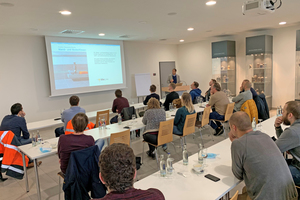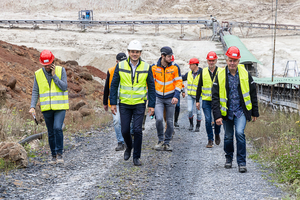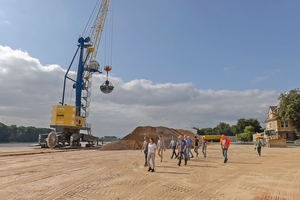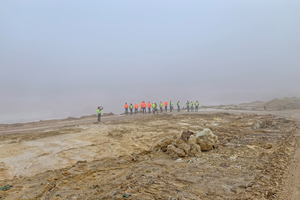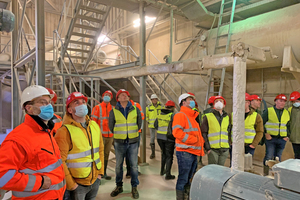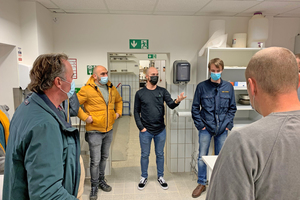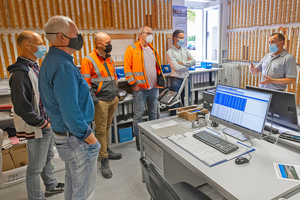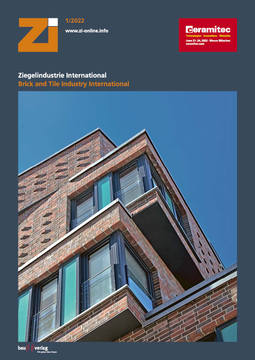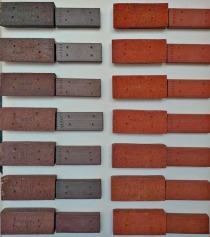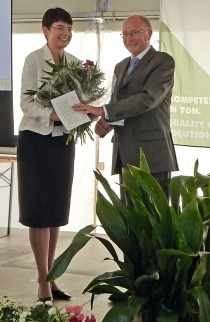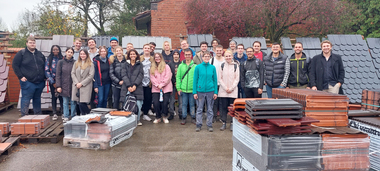TCKI excursion at Stephan Schmidt in the Westerwald
For many years now, students on the post-HBO course at the TCKI (Technical Centre for the Ceramics Industry) have visited Stephan Schmidt KG in Langendernbach after having completed their course module on raw materials. This excursion traditionally takes place in November, under the direction of Hans van Wijck. As the excursion had unfortunately not been possible in Corona year 2020, two events, each with around 20 students, were held in 2021: the date for the postponed excursion being in September while the traditional annual excursion went ahead in November. For both excursions, most of the visitor groups came from the heavy clay ceramics sector.
75 years of experience
Stephan Schmidt, Managing Partner, personally welcomed the groups and presented the raw materials company.
His claim that every person uses around 29 t clay over 70 years gave rise to some astonishment. Stephan Schmidt emphasized how “Quality plays a very special role” for his company. The raw materials supplier, now under the ownership of the third generation of the family, celebrates its 75th anniversary in 2022.
The Schmidt Group is known for supplying raw material blends with consistent quality. In 20 surface mines, including 16 in the Westerwald region, two in Central Hesse and two in Eastern Germany, around 400 tonnes clay are extracted – that is approx. 1.6 mill. tonnes annually. In 2021, the Group introduced a new raw material characterization, with which the individual mined clays are distinguished on the basis of various parameters. Based on these characterizations, the different clay blends are prepared. Most of these blends are specifically adapted to customer needs. Depending on customer requirements, they are further processed to ground clay or granulate bodies. Besides its Ceramics Division, Stephan Schmidt Group has been successfully working in areas outside the ceramics industry for many years. For the students, some applications for speciality clays were new, e.g. borehole sealing.
From mined clay to ground product
The theory-based introduction was followed by a practical session: The September group, in the meantime experienced ceramics students, had the good fortune to view the Wimpsfeld pit and then the homogenization, preparation and grinding facility at Maienburg in glorious weather.
At the Wimpfsfeld mine, the visitors were impressed by the selective extraction of the individual layers of clay. To reach these, a large quantity of overburden must be stripped and moved. For the students, all of whom work in ceramics companies and study part-time, so to speak, it was really worth seeing how much effort is involved in extracting the clay. At Maienburg, predominantly white-firing clays are processed. The students had the opportunity to learn about the entire value-added chain – from pit clay to enamel clays packed into bags.
During the November visit, the weather was unfortunately not so favourable: dense fog billowed through Meudt pit so that the visitors were hardly able even to make out the bottom of the currently around 50-m-deep pit. The largest pit of Stephan Schmidt Group was impressive, nevertheless. The around 500 000 t of clays extracted per year include light-firing clays, along with the well-known red grades, which many of the participants process in their plants to produce bricks and tiles. Stephan Schmidt Group has big plans for this pit. Investment will start from 2022, with a belt conveyor and new bays, with preparations already underway in 2021. During the subsequent tour around the Sedan mixing and grinding plant, the students were able to trace the route from the pit through ground clay to red-firing granulate bodies.
Certified quality
Following a lunch at the Schmidt Group headquarters, the students were split into two groups and started their tour through the laboratories and the development department.
Olaf Schlimm, Manager of the Central Laboratory and QA, explained the route of clay samples through the different QA areas, starting with a representative sample from the pit through to the QA certificate for the customer. Maximilian Ferdinand, who heads the Application Engineering unit, presented the development department. He clearly explained to the students how all new products are developed in close cooperation with the customer.
Off all over the world
After the official part in Langendernbach, some of the participants made an interim stop at Bendorf Harbour. Stephan Schmidt Group supplies its speciality clays worldwide, by lorry, rail or ship. From Bendorf Harbour, large quantities, above all red-firing clays, are transported by ship to brickworks in Germany, Belgium and the Netherlands.
New excursion planned
For 2022, too, another excursion of the TCKI is planned. Stephan Schmidt looks forward to perhaps welcome Ronny Lugtenberg together with the students and their teacher Hans van Wijck. Alongside his work as TCKI Director, Ronny Lugtenberg, the successor to Hans van Wijk, will assume responsibility for further training of the students in the medium term.
Diese Ausbildung zum Keramiker wird vom Niederländischen Fachverband „Koninklijke Nederlandse Bouwkeramiek“ (KNB) und „Fontys Hogescholen“ (Fontys Fachhochschule) in Eindhoven durchgeführt. Hans van Wijck und Hans Marks (beide TCKI – Technisches Zentrum für die Keramische Industrie) sind seit vielen Jahren für die Ausbildung der Studenten verantwortlich.
Die Ausbildung dauert acht Monate, in der Regel von Mitte Oktober bis Ende Juni des Folgejahres und umfasst 21 Unterrichtsnachmittage. Das Unterrichtsprogramm umfasst die Themen Rohstoffe, Masseaufbereitung, Formgebung, Trocknen, Brennen, Glasieren, Materialeigenschaften, Umwelt- und Arbeitsbedingungen sowie Energie. Im Fokus stehen die Grob- und Feinkeramik, behandelt werden auch die Feuerfest und die Technische Keramik. Rund 20 Teilnehmer, zumeist Mitarbeiter von Ziegel-, Dachziegel und Fliesenherstellern in den Niederlanden und Belgien, nehmen daran teil. Dabei werden sowohl die theoretischen Hintergründe des keramischen Herstellungsprozesses als auch praxisorientierte und aktuelle technologische und technische Aspekte behandelt.
Bestandteil der Ausbildung sind vier Exkursionstage, an denen neben dem TCKI-Labor die Unternehmen der Ziegel-, Dachziegel-, Fliesen- sowie der Feuerfestindustrie und der technischen Keramik besucht werden. Am ersten Exkursionstag steht die Stephan Schmidt KG in Langendernbach auf dem Programm.
Die Studenten müssen drei Prüfungen bestehen und einen Abschlussbericht nach einem Selbststudium zu einem der Themen Energie, Umwelt oder Arbeitsbedingungen erstellen. Nach einer der intensiven Studienzeit schließt ein Großteil der Studenten die anspruchsvolle Ausbildung mit einem Diplom ab.

